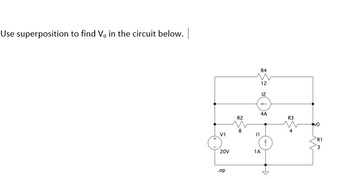
Introductory Circuit Analysis (13th Edition)
13th Edition
ISBN: 9780133923605
Author: Robert L. Boylestad
Publisher: PEARSON
expand_more
expand_more
format_list_bulleted
Concept explainers
Question

Transcribed Image Text:**Use superposition to find \( V_0 \) in the circuit below.**
**Circuit Description:**
- **Voltage Source (\( V_1 \)):** 20V
- **Current Source (\( I_1 \)):** 1A
- **Dependent Current Source (\( I_2 \)):** 4A
- **Resistors:**
- \( R_1 \): 3 ohms
- \( R_2 \): 8 ohms
- \( R_3 \): 4 ohms
- \( R_4 \): 12 ohms
**Diagram Explanation:**
The circuit diagram shows a configuration with a mix of voltage and current sources along with four resistors. The task is to determine the voltage \( V_0 \) across \( R_1 \) (3 ohms) using the superposition method. The circuit configuration requires analyzing each source independently, followed by combining their effects to find the resultant \( V_0 \).
1. **Voltage Source \( V_1 \) (20V) Analysis:**
- Turn off the current sources (\( I_1 \) and \( I_2 \)) by replacing them with open circuits.
- Calculate the contribution to \( V_0 \) due to \( V_1 \).
2. **Current Source \( I_1 \) (1A) Analysis:**
- Turn off the voltage source \( V_1 \) by replacing it with a short circuit.
- Handle the dependent current source \( I_2 \), as it depends on other circuit parameters.
- Calculate the contribution to \( V_0 \) due to \( I_1 \).
3. **Dependent Current Source \( I_2 \) (4A) Analysis:**
- Consider the operation as per its dependence.
- Analyze the effect on \( V_0 \).
**Combining Effects:**
- Add the effects of each source to find the total voltage \( V_0 \) across \( R_1 \).
Using superposition helps to simplify the analysis of complex circuits by focusing on one independent source at a time, making the problem more manageable.
Expert Solution
This question has been solved!
Explore an expertly crafted, step-by-step solution for a thorough understanding of key concepts.
Step by stepSolved in 4 steps with 3 images

Knowledge Booster
Learn more about
Need a deep-dive on the concept behind this application? Look no further. Learn more about this topic, electrical-engineering and related others by exploring similar questions and additional content below.Similar questions
- 11) For the Circuit, determine the values of different Resistors, if the source Current is (I = 16 mA). a) Find the Resistors – (R1), (R2), (R3), (R4)? O+48 V R1 R2 O+12 V + 16 mA E= 100 V R4 -20 Varrow_forwardUsing the circuit below: a. Redraw the circuit where R5 = 7k2 b. Find Vout (the voltage across R4) 2kQ + R4 2kQ Vout 6kO $6kQ 10V R5arrow_forwardUsing the superposition theorem, find the current through R1 in Figure below. R R3 100 Ω 100 0 Vsi R2 100 0 Vs2 5 Varrow_forward
- Find the current i for the circuit of the Figure. Hint: A short circuit can be treated as a 0-V voltage source. The value of current i in Amp isarrow_forwardFor the circuit in the given figure, use KCL to find the branch currents to 14. Assume A = 5 A, B = 19 A, C = 4 A, and D = 4 A. 12 C B 13 The branch currents 4, 12, 13, and 14 are A, A, A, and A, respectively.arrow_forward
arrow_back_ios
arrow_forward_ios
Recommended textbooks for you
 Introductory Circuit Analysis (13th Edition)Electrical EngineeringISBN:9780133923605Author:Robert L. BoylestadPublisher:PEARSON
Introductory Circuit Analysis (13th Edition)Electrical EngineeringISBN:9780133923605Author:Robert L. BoylestadPublisher:PEARSON Delmar's Standard Textbook Of ElectricityElectrical EngineeringISBN:9781337900348Author:Stephen L. HermanPublisher:Cengage Learning
Delmar's Standard Textbook Of ElectricityElectrical EngineeringISBN:9781337900348Author:Stephen L. HermanPublisher:Cengage Learning Programmable Logic ControllersElectrical EngineeringISBN:9780073373843Author:Frank D. PetruzellaPublisher:McGraw-Hill Education
Programmable Logic ControllersElectrical EngineeringISBN:9780073373843Author:Frank D. PetruzellaPublisher:McGraw-Hill Education Fundamentals of Electric CircuitsElectrical EngineeringISBN:9780078028229Author:Charles K Alexander, Matthew SadikuPublisher:McGraw-Hill Education
Fundamentals of Electric CircuitsElectrical EngineeringISBN:9780078028229Author:Charles K Alexander, Matthew SadikuPublisher:McGraw-Hill Education Electric Circuits. (11th Edition)Electrical EngineeringISBN:9780134746968Author:James W. Nilsson, Susan RiedelPublisher:PEARSON
Electric Circuits. (11th Edition)Electrical EngineeringISBN:9780134746968Author:James W. Nilsson, Susan RiedelPublisher:PEARSON Engineering ElectromagneticsElectrical EngineeringISBN:9780078028151Author:Hayt, William H. (william Hart), Jr, BUCK, John A.Publisher:Mcgraw-hill Education,
Engineering ElectromagneticsElectrical EngineeringISBN:9780078028151Author:Hayt, William H. (william Hart), Jr, BUCK, John A.Publisher:Mcgraw-hill Education,

Introductory Circuit Analysis (13th Edition)
Electrical Engineering
ISBN:9780133923605
Author:Robert L. Boylestad
Publisher:PEARSON

Delmar's Standard Textbook Of Electricity
Electrical Engineering
ISBN:9781337900348
Author:Stephen L. Herman
Publisher:Cengage Learning

Programmable Logic Controllers
Electrical Engineering
ISBN:9780073373843
Author:Frank D. Petruzella
Publisher:McGraw-Hill Education

Fundamentals of Electric Circuits
Electrical Engineering
ISBN:9780078028229
Author:Charles K Alexander, Matthew Sadiku
Publisher:McGraw-Hill Education

Electric Circuits. (11th Edition)
Electrical Engineering
ISBN:9780134746968
Author:James W. Nilsson, Susan Riedel
Publisher:PEARSON

Engineering Electromagnetics
Electrical Engineering
ISBN:9780078028151
Author:Hayt, William H. (william Hart), Jr, BUCK, John A.
Publisher:Mcgraw-hill Education,